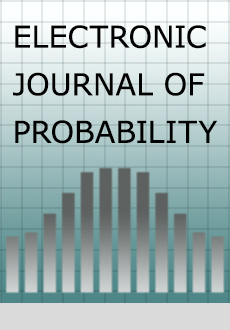Abstract
Consider the random hypercube $H_2^n(p_n)$ obtained from the hypercube $H_2^n$ by deleting any given edge with probabilty $1 -p_n$, independently of all the other edges. A diameter path in $H_2^n$ is a longest geodesic path in $H_2^n$. Consider the following two ways of tampering with the random graph $H_2^n(p_n)$: (i) choose a diameter path at random and adjoin all of its edges to $H_2^n(p_n)$; (ii) choose a diameter path at random from among those that start at $0=(0,\cdots, 0)$, and adjoin all of its edges to $H_2^n(p_n)$. We study the question of whether these tamperings are detectable asymptotically as $n\to\infty$.
Citation
Ross Pinsky. "Detecting tampering in a random hypercube." Electron. J. Probab. 18 1 - 12, 2013. https://doi.org/10.1214/EJP.v18-2290
Information





